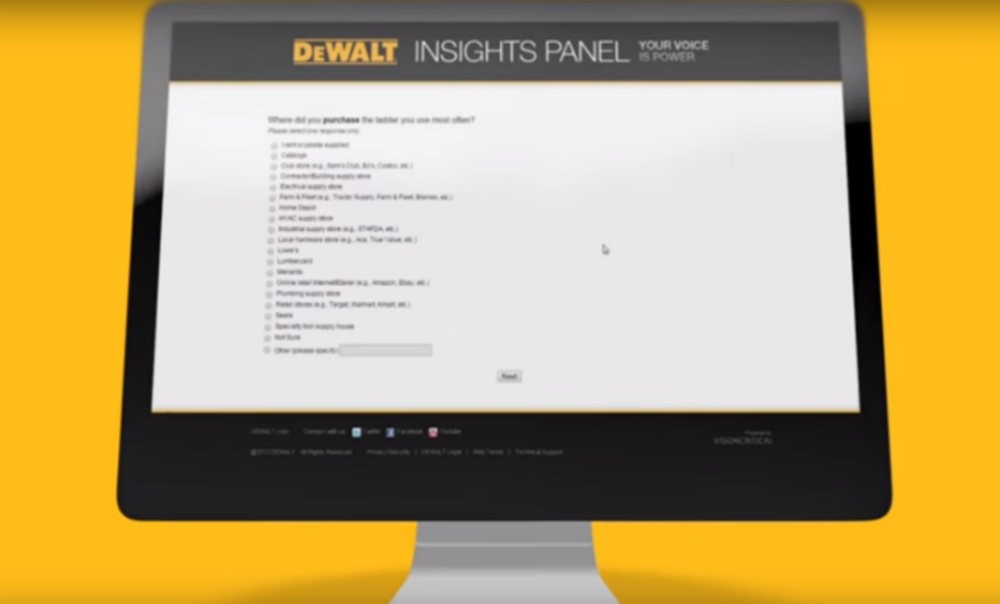Marketing is all about solving problems, and having the proper tools can help marketers fix major issues. Customer insights are the true nuts and bolts of decision making for DeWALT’s marketing organization. The power tool brand collects quantitative and qualitative data from its customer community to better its products throughout the entire development journey.
Nailing down the issues
When Shannon Chenoweth joined DeWALT’s parent company Stanley Black & Decker in 2012, she faced a few problems with leveraging the organization’s internal database. First, the power tools brand had to screen each professional tradesman every time it sent out a survey. In other words, it couldn’t save such customer information as their trade or filter them by career. So, even if the brand wanted to send a survey just to electricians, it would have to blast it out to everyone. Second, DeWALT had a community engagement rate of only 1%.
“We’d have to keep sending [the surveys] out and sending them out and hoping that they were going to answer our questions,” says Chenoweth, Stanley Black & Decker’s market research manager.
Wanting to build up the research department’s credibility—and knowing the only way to go was up—Chenoweth decided to implement Vision Critical’s customer intelligence platform Sparq that year.
Constructing a new community
Sparq enables DeWALT to form an Insight Community through which it can engage and derive learnings from thousands of customers, mainly through surveys and online discussion forums. The brand’s marketers might ask customers general questions about their favorite sports teams or TV shows for branding and campaign ideas, Chenoweth explains, or it may solicit more product-related feedback, such as how much a customer would pay for a particular item or which features are most important to him. DeWALT’s marketers can also direct questions to specific audiences. “We use them for anything and everything,” Chenoweth says.
In addition to implementing the customer intelligence platform, DeWALT installed Vision Critical’s IdeaScreen within it first year. IdeaScreen is an early concept testing tool. DeWALT can use it to pitch product ideas to community members and then screen and score their feedback. It also added Vision Critical’s IdeaHub last year. This crowdsourcing tool, paired with IdeaScreen, allows DeWALT to gather product ideas from its community, evaluate them, and then co-create through member feedback. For instance, Chenoweth says DeWALT might ask its community to design a multi-port charger.
Using this combination of tools, she adds, allows DeWALT to play off of customers’ various strengths.
“We wanted everybody to participate, but everybody’s strengths are in different places,” she says. “There are some people who are really good with coming out with pie-in-the-sky ideas, and there are other people who can’t even think about what [those] could be. But if you give them some structure, they can certainly add on.”
Drilling down the development process
DeWALT’s product managers are the ones who receive the majority of the community feedback. This insight helps guide their product development from concept to packaging.
For example, when DeWALT was getting ready to release a new premium battery a year ago, it wanted to ensure that customers didn’t confuse it with older models. As the video above shows, the company ran a survey to see how well customers understood differences in function and labeling and applied those learnings to its go-to-market strategy.
“That really drove the differentiation in the marketplace among those batteries, as well as with the labeling,” Chenoweth says.
Creating and tweaking these products based on customer feedback is important, Chenoweth notes, because it allows the brand to ensure that its tools meet customers’ day-to-day professional needs.
“If we don’t go out and talk to them, we can design a tool based on what I think,” Chenoweth says, “but I’m not going to hold it for eight hours.”
Vision Critical’s tools also help DeWALT see how its products and brand experiences compare to its competitors. For example, in preparation for its website redesign, DeWALT asked community members to visit competitors’ websites and comment on what they liked and didn’t like via an online discussion forum.
But DeWALT isn’t the only one that benefits from this relationship. Customers who answer survey questions have the chance to win $50 Amazon gift cards through a monthly drawing, and those who participate in the IdeaHub have the chance to win $250 or $1,000 gift cards. However, Chenoweth says that it’s the feeling of being heard—rather than the incentives—that lure customers to participate.
“They like giving us information and telling us what they want and what they need,” she says, “because if they have some say in the design, that just helps them because they’re using these tools every single day.”
Securing great results
Since launching the Vision Critical platform, DeWALT has upped its community engagement rates to 30%. The power tools company also grew its number of community members from 8,000 its first year to more than 10,000 today. Chenoweth says she hopes to raise this number to 15,000.
For marketers hoping to replicate DeWALT’s success, Chenoweth stresses the importance of being able to make recommendations and tell stories through data—not just share it. She also encourages marketers to ensure that their community members feel appreciated and heard.
“You need to make sure that they feel valued,” she says. “You need to make sure that when you’re asking [for] their feedback, that you’re doing something with it—that they know that their voice matters to you.”








